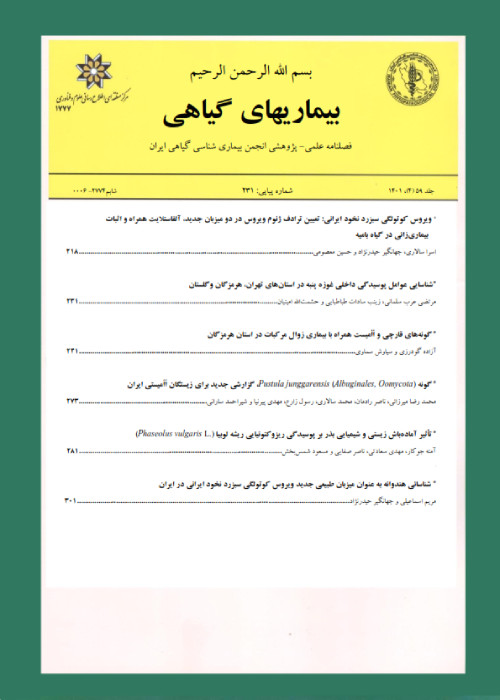First report of pathogenicity group 3 and 4 Leptosphaeria maculans, the causal agent of blackleg disease of oilseed rape in Northern Iran
Author(s):
Abstract:
The rapeseed (Brassica napus) is an important oilseed crop throughout the world for oil production. Blackleg disease which caused by Leptosphaeriamaculans is one of the most important disease of rapeseed in Iran. Among pathogenicity groups PG-1 (Leptosphaeria biglobosa) and PG-2, PGT (L. maculans) has been reported on rapeseed from Mazandaran and Golestan provinces of northern Iran (Fernando et al. 2007, Mirabadi et al. 2010). The samples (leaves, stem, flowers and seed) with symptoms of diseases such as discoloration, deformation, wrinkled and presence of pycnidia were collected during 2013-2016 from canola crops in North Iran. In addition, some of the stem debris with stem canker symptoms was examined for the presence and absence of pathogen sexual (perfect) state. Diseased tissues (leaves, stems, flowers and seed) were surface sterilized to obtain pathogen isolates following the procedure described by West et al. (2002) and Chen et al. (2010). Single ascosporic cultures of the fungus were isolated from psedothecia using the method developed by Li et al. (2004). In all 102 isolates when the causal pathogen was isolated from infected tissues, it was identified as L. maculans, by colony morphology/ pigment production on potato dextrose agar (PDA) and potato dextrose broth (PDB) respectively (Boerema et al. 2004), and species specific polymerase chain reaction (PCR) (Liu et al. 2006). The pycnidia of the fungus were black, globose to subglobose in shape, parts of pycnidia have pale pink droplet overflowed from the ostiole and Asci are clavate to cylindrical, bitunicate and 8 spores. Moreover, all isolates were classified as highly virulent using PCR with virulence type specific primers (Kuusk et al. 2002). Thirty-two isolates of L. maculans were used for determining the pathogenicity test using a cotyledon inoculation method. Pathogenicity of the isolates was confirmed by spraying a conidial suspension of the fungus (2×107 conidia mL-1) on cotyledons of Westar, Quinta and Glacier cultivars. All plants were maintained in a growth chamber at 22°C with 16 h light period and relative humidity of 80%. The first review of the plants was performed after 5 days and changes during experimenting plants have been observed after 12 days using the scale of 09 developed by Chen & Fernando (2006) which 0 to 3 reaction was considered as resistant (R), 4 to 6 as intermediate (I) and 7 to 9 as susceptible (S) (Fig. 1). Sixteen of isolates were classified as belonging to pathogenicity group PG-4. They were characterized by their ability to sporulate on the three differential hosts (S=7-9). Three isolates were PG-3, they sporulated on Westar and Glacier, and caused brown, non sporulating lesion on Quinta (I=4-6). The remaining isolates belonged to PG-2 and PGT. Moreover, our findings provided evidence that L. maculans (PG-4) is present on oilseed rape seeds in the North Iran. Our results showed that an understanding of possible shift in fungus populations will be of value in developing strategies for successful management of blackleg disease such as longer rotation between canola crops, new resistant cultivars against all PG isolates and strict regulations concerning crop seed trade. In addition, the current study is the first report on the identification of L. maculans (PG-3, PG-4) from oilseed in Northern Iran.
Keywords:
Language:
Persian
Published:
Iranian Journal of Plant Pathology, Volume:52 Issue: 4, 2017
Pages:
551 to 554
magiran.com/p1673557
دانلود و مطالعه متن این مقاله با یکی از روشهای زیر امکان پذیر است:
اشتراک شخصی
با عضویت و پرداخت آنلاین حق اشتراک یکساله به مبلغ 1,390,000ريال میتوانید 70 عنوان مطلب دانلود کنید!
اشتراک سازمانی
به کتابخانه دانشگاه یا محل کار خود پیشنهاد کنید تا اشتراک سازمانی این پایگاه را برای دسترسی نامحدود همه کاربران به متن مطالب تهیه نمایند!
توجه!
- حق عضویت دریافتی صرف حمایت از نشریات عضو و نگهداری، تکمیل و توسعه مگیران میشود.
- پرداخت حق اشتراک و دانلود مقالات اجازه بازنشر آن در سایر رسانههای چاپی و دیجیتال را به کاربر نمیدهد.
In order to view content subscription is required
Personal subscription
Subscribe magiran.com for 70 € euros via PayPal and download 70 articles during a year.
Organization subscription
Please contact us to subscribe your university or library for unlimited access!



